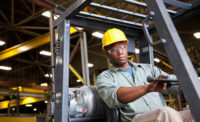Employers across the world allow their employees to listen to music each day while on the job. Allowing workers to jam out can boost workplace morale, job satisfaction and productivity.
Listening to music is increasingly popular in construction-related fields since canceling out loud noise is required to protect hearing. The problem is that listening to tunes while performing high-risk jobs can often lead to unfortunate accidents.
The laws and regulations related to music listening while on high-risk job sites are constantly debated. Since this issue is becoming prominent around construction worker headphones, OSHA has responded with the set of guidelines and recommendations for various listening devices.
Background of the issue
A recent shift from radios and speaker systems to headphones and Bluetooth devices on project sites is leading to an increase in personal music listening. The primary reason workers are allowed to use headphones while on the job is that OSHA construction guidelines require that employers provide hearing protection if workers are exposed to any level of noise above a certain decibel level.
Headphones and other music listening devices might not be a perfect substitute for actual hearing protection. However, it's easy to blur the lines between the two types of wearables when headphones provide ambient noise reduction.
The risks of on-site noise interference
The primary reason OSHA is addressing this subject is because numerous problems can arise from personal music use. When someone is listening to music through headphones or earbuds, they're much less likely to hear anything else around them, posing severe risks to themselves and others.
The incidents on construction sites that sparked this debate are due to workers being injured or killed because of their inability to hear warning noises over the music they were listening to.
OSHA's claims and recommendations
The injury concern that OSHA is attempting to prevent is known as struck-by hazards. This type of workplace risk is the costliest and deadliest, responsible for any impact or collision between a piece of machinery and worker.
In addition, frequent falls and slips end up costing employers over $5 billion a year. Both types of accidents can be easily caused by workers who are not able to hear warnings and approaches from objects in and around a construction site.
In the letter addressing this issue, OSHA explains that it's up to the employer's discretion whether to allow employees to listen to music while operating or being around heavy machinery. They also state that they do not license, inspect or certify any headphones or ear protection devices.
This statement from OSHA is a little surprising, and no current law or regulation exists preventing workers from listening to music while on high-risk job sites.
Construction workers and headphones
In essence, since the line between ear protection and listening devices is vague, OSHA is not willing to state that workers can't listen to music while performing their duties. Although, the agency does interject that employers have an obligation to protect employees and provide a safe working environment, which may include construction headphones.
In the instances that first spurred this debate, the employers were ultimately liable under the Occupational Safety and Health Act. Although, since it is not technically illegal to allow workers to listen to music, this issue can be vague and confusing for organizations in the construction and heavy equipment sectors.
For employers considering this new statement by OSHA, it might be best to look at the particular circumstances. Organizations must determine if the benefits of workers listening to music outweigh the risks they may incur while doing so.




